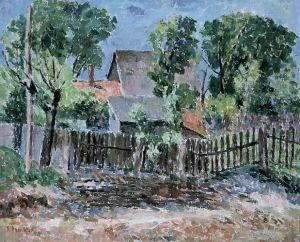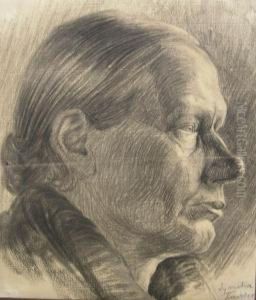Symche Trachter Paintings
Symche Trachter was a Polish-Jewish painter born on September 17, 1894, in Lublin, Poland. He grew up in a time when Poland was not an independent nation but was partitioned between Russia, Austria, and Germany. Growing up in an environment with a rich Jewish tradition and culture, Trachter's early life and experiences would later influence his artistic works, which often included Jewish motifs and subjects.
Trachter's artistic talents became evident early on, and he pursued his passion for art by studying at the Academy of Fine Arts in Warsaw. His education was interrupted by World War I, but he continued to develop his skills and was able to resume his studies after the war. In the 1920s, Trachter became part of the vibrant art scene in Warsaw, which was a melting pot of various artistic styles and movements. He was particularly interested in the avant-garde and was associated with other Jewish artists who sought to create a modern Jewish art that was both rooted in tradition and looking forward to contemporary trends.
In the 1930s, Trachter's work gained recognition, and he participated in numerous exhibitions in Poland and abroad. His style was characterized by a combination of modernist abstraction and figurative painting, often incorporating elements of cubism and expressionism. He had a fondness for using bright colors and dynamic compositions, which made his paintings stand out. Trachter's subjects ranged from landscapes and still lifes to scenes of Jewish life and religious practice, reflecting his deep connection to his heritage.
Unfortunately, Symche Trachter's life and career were cut tragically short by the events of World War II. With the Nazi invasion of Poland in 1939, Trachter, like many other Jews, found himself in a perilous position. He was ultimately captured and perished in the Holocaust, with 1942 marking the year of his death. The exact circumstances of his demise are not well-documented, which is the case for countless victims of the Holocaust.
Trachter's legacy lives on through his artwork, some of which survived the war and can be found in various collections. His contribution to Jewish art is particularly significant as it represents a bridge between traditional Jewish themes and modern artistic expression. Despite the loss of much of his work during the war, Trachter is remembered as an important figure in the Jewish artistic community of the early 20th century, and his surviving pieces offer a poignant glimpse into a vibrant cultural world that was nearly destroyed.

